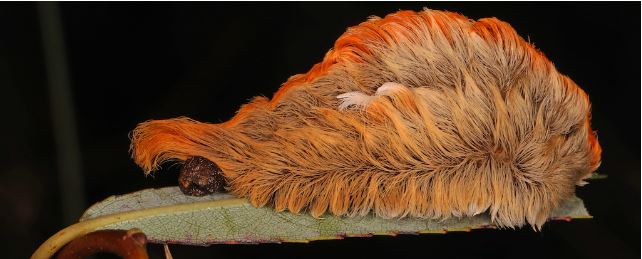


 2:32:37
2:32:37  2023-09-22
2023-09-22  1404
1404

Caterpillars with a notoriously painful sting may have evolved their venom with help from ancient microbes, according to a new study led by scientists from the University of Queensland in Australia.
Their analysis has uncovered signs that a process known as horizontal gene transfer may have allowed sequences for toxins to jump from bacteria to the insect some time in their evolutionary past.
While the caterpillar's venom remains largely shrouded in mystery, researchers say its molecular secrets could turn out to be surprisingly beneficial for us.
The caterpillars wielding this venom are larvae of flannel moths (Megalopyge sp.); a soft, fuzzy genus native to North and South America. They're sometimes called "puss caterpillars," since their luxuriant coats of hairlike bristles can make them look sort of like caterpillar-sized cats.
But that's not their only nickname. Also known as "asp caterpillars," there's a hidden danger below those bristles.
The caterpillars' fur obscures an arsenal of venomous spines, which can inject powerful toxins into any would-be predators or hapless humans who touch them.
This venom causes an immediate and intense burning pain, commonly inspiring descriptions such as "being hit with a baseball bat," "walking on hot coals," or "the worst pain a patient has ever experienced," the researchers write.
Some animal venoms have proven useful to humans in recent years, and a growing field of research now views them as potential goldmines. Certain snake and spider venoms, for example, show "amazing potential" to inspire new medications, the study's authors say.
And since caterpillar venoms have received relatively little scientific attention s far, the researchers decided to investigate venom from some of the scariest caterpillars on Earth.
Their study focused on two moth species - the southern flannel moth (Megalopyge opercularis) and the black-waved flannel moth (Megalopyge crispata) - to shed light on the anatomy, chemistry, and mode of action for venom systems in asp caterpillars.
They discovered a venom system that differed substantially not only from closely related venomous caterpillars, but also from insects in general.
"We were surprised to find asp caterpillar venom was completely different to anything we had seen before in insects," says University of Queensland molecular entomologist Andrew Walker.
The quirks of asp caterpillar venom support the idea it evolved independently from other insect venom, the researchers say. In fact, its origins seem to lie outside the animal kingdom entirely.
"When we looked at it more closely, we saw proteins that were very similar to some of the bacterial toxins that make you sick," Walker says.
Specifically, asp caterpillar venom resembles a type of bacterial toxin that binds itself to the surface of a cell, the researchers explain, assembling into doughnut-like structures that rip holes in their cell target.
While organisms normally pass genes down their offspring in a so-called vertical fashion, sometimes genes can be transferred across between species - even distantly related ones - in a less common horizontal process.
Previous research has found evidence of horizontal gene transfer from bacteria to other, more complex creatures, including the transfer of genes involved with producing venom toxins.
In their new study, Walker and his colleagues say they've found evidence that major components of asp caterpillar venom were recruited as venom toxins from genes that bacteria transferred horizontally to their ancestors.
"The venom in these caterpillars has evolved via the transfer of genes from bacteria more than 400 million years ago," Walker says.
Moths and butterflies have a wide range of strategies to protect themselves in their larval stages, and research like this can offer new insights into these amazing adaptations - including the different ways they arose and evolved. "Many caterpillars have developed sophisticated defenses against predators, including cyanide droplets and defensive glues that cause severe pain, and we're interested to understand how they are all related," Walker says.
In addition to sheer curiosity, humans are also studying these caterpillars in hopes of finding some tangible rewards for our species. Understanding venom can help us protect ourselves from it, and can give us new ideas for developing or improving things like medications and pesticides.
In asp caterpillar venom, the newly identified megalysin toxins cause intense pain by forming holes in cells. If humans can mimic and modify this tactic, we might find ways to channel 400 million years of moth evolution into life-saving innovations instead of just painful stings.
"Toxins that puncture holes in cells have particular potential in drug delivery because of their ability to enter cells," Walker says.
"There may be a way to engineer the molecule to target beneficial drugs to healthy cells, or to selectively kill cancer cells."
Reality Of Islam |
|

Researchers

A new chip-

A large inf

Choosing th
 9:3:43
9:3:43
 2018-11-05
2018-11-05
10 benefits of Marriage in Islam
 7:5:22
7:5:22
 2019-04-08
2019-04-08
benefits of reciting surat yunus, hud &
 9:45:7
9:45:7
 2018-12-24
2018-12-24
advantages & disadvantages of divorce
 11:35:12
11:35:12
 2018-06-10
2018-06-10
 6:0:51
6:0:51
 2018-10-16
2018-10-16
 8:19:41
8:19:41
 2018-06-21
2018-06-21
allah will not answer all your prayers
 6:56:28
6:56:28
 2022-01-01
2022-01-01
 2:5:14
2:5:14
 2023-01-28
2023-01-28
 7:59:14
7:59:14
 2018-06-21
2018-06-21
 5:57:34
5:57:34
 2023-03-18
2023-03-18
 12:47:1
12:47:1
 2022-12-20
2022-12-20
 8:25:12
8:25:12
 2022-03-09
2022-03-09
 5:41:46
5:41:46
 2023-03-18
2023-03-18
| LATEST |